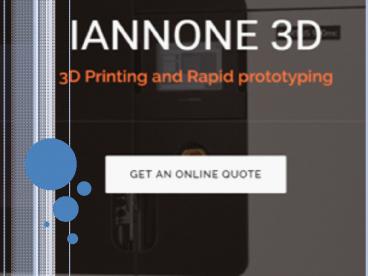3d printing rapid prototyping PowerPoint PPT Presentation
Title: 3d printing rapid prototyping
1
(No Transcript)
2
What is 3D printing?
- 3D printing also known as additive manufacturing
is a process of making three dimensional solid
objects from a digital file typically by laying
down many successive thin layers of a material. - Successive layers of material are formed
under computer control to create an
object. Objects can be of almost any shape or
geometry and are produced from digital model
data 3D model or another electronic data source.
3
How does 3D printing work?
- The 3D printing process turns a whole object into
thousands of tiny little slices, then makes it
from the bottom-up, slice by slice. - Those tiny layers stick together to form a solid
object. Each layer can be very complex,
meaning 3D printers can create moving parts like
hinges and wheels as part of the same object.
4
How to learn 3D Printing
- When jumping into the world of 3D printing, its
a good idea to assemble a kit yourself to get a
basic idea of how they are built and how 3D
printers function. - While following the instructions and putting the
parts together youll gradually learn all the
terms and vocabulary associated with 3D printing
which will make it easier to solve problems in a
later stage.
5
Processes and technologies
- Not all 3D printers use the same technology.
There are several ways to print and all those
available are additive, differing mainly in the
way layers are build to create the final object. - Some methods use melting or softening material to
produce the layers. Selective laser sintering
(SLS) and fused deposition modelling (FDM) are
the most common technologies using this way of 3D
printing. - Another method is when we talk about curing a
photo-reactive resin with a UV laser or another
similar power source one layer at a time. The
most common technology using this method is
called stereo lithography (SLA).
6
Examples applications of 3D printing
- Applications include rapid prototyping,
architectural scale models Marquette, and
entertainment. - Examples of 3D printing would include
reconstructing fossils in palaeontology,
replicating ancient artefacts in archaeology,
reconstructing bones and body parts in forensic
pathology and reconstructing heavily damaged
evidence acquired from crime scene investigations.
7
Future 3D printing
- 3D printers capable of outputting in colour and
multiple materials already exist and will
continue to improve to a point where functional
products will be able to be output. - With effects on energy use, waste reduction,
customization, product availability, medicine,
art, construction and sciences, 3D printing will
change the manufacturing world as we know it.
8
Contact us
Address 698 Clems Run City Monroeville State
NJ Country USA Zip code "08343" Phone no
(856)-244-1940 Client Mail sales_at_iannone3d.com W
eb site http//www.iannone3d.com/
9
(No Transcript)

